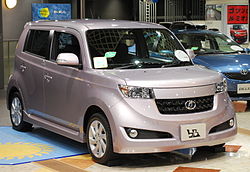Model gallery
- Toyopet Toyoace SKB
1956–1959 - Toyopet Masterline
1957–1961 - Toyopet Publica Convertible
1963–1968 - Toyopet Corona Pickup
(1964 bis 1968) - Toyopet Corona Van
1965–1970 - Toyopet Corona Van
1973–1978 - Toyopet Crown Station Wagon
1974–1979 - Toyota Carina
1975–1977 - Toyota Carina
1977–1981 - Toyota Corona Sedan
1978–1981 - Toyota Corona Van
(1978–1982) - Toyota Crown Station Wagon
1979–1983 - Toyota Carina
1981–1987 - Toyota Corona Van
1982–1987 - Toyota MR2
1984–1989 - Toyota MR2
1989–1999 - Toyota Sera
1990–1995 - Toyota Caldina
1993–1997 - Toyota Caldina Van
1993–2002 - Toyota Hiace
1993–1996 - Toyota Hiace
1996–2000 - Toyota Raum
1997–2003 - Toyota MR-S
1999–2007 - WiLL Vi
2000–2001 - WiLL VS
2001–2004 - Toyota Allex
2001–2007 - Toyota Corolla RunX
2001–2007 - WiLL Cypha
2002–2005 - Toyota Raum
since 2003 - Toyota bB
2004–2005 - Toyota bB
2005–2007 - Toyota Corolla
2006–2013 - Toyota Corolla Axio
2006–2012 - Toyota Belta
2007–2012 - Toyota Corolla Axio
since 2012
Additional models that have no pictures yet:
- Toyota Dyna (1957–1959)
- Toyopet Type FS Ambulance (1961–1968)
- Toyopet Corona Mark II PickUp (1968–1971)
- Toyopet Crown Station Wagon (1973–1974)
- Toyopet Corona Van (1970–1973)
- Toyota Carina Surf (1982–1987)
- Toyota Tundra (CKD kits only)


































